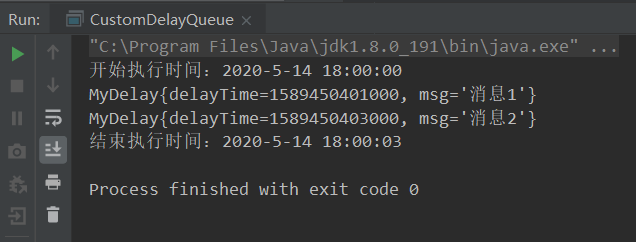如何手动实现一个消息队列和延迟消息队列?
如何手动实现一个消息队列和延迟消息队列?
我们可以通过 JDK 提供的 Queue 来实现自定义消息队列,使用 DelayQueue 实现延迟消息队列。
我们可使用 Queue 来实现消息队列,Queue 大体可分为以下三类:
• **双端队列(Deque)**是 Queue 的子类也是 Queue 的补充类,头部和尾部都支持元素插入和获取;
• 阻塞队列指的是在元素操作时(添加或删除),如果没有成功,会阻塞等待执行,比如当添加元素时,如果队列元素已满,队列则会阻塞等待直到有空位时再插入;
• 非阻塞队列,和阻塞队列相反,它会直接返回操作的结果,而非阻塞等待操作,双端队列也属于非阻塞队列。
Queue 来实现自定义消息队列
/** * @author 佛大Java程序员 * @since 1.0.0 */ public class CustomQueue { /** * 定义消息队列 */ private static Queue<String> queue = new LinkedList<>(); public static void main(String[] args) { producer();// 调用生产者 consumer();// 调用消费者 } // 生产者 public static void producer(){ // 添加消息 queue.add("first message."); queue.add("second message."); queue.add("third message."); } // 消费者 public static void consumer(){ while (!queue.isEmpty()){ // 消费消息 System.out.println(queue.poll()); } } }
运行结果

DelayQueue 实现延迟消息队列
实现自定义延迟队列需要实现 Delayed 接口,重写 getDelay() 方法。
实现 Delayed 接口
/** * @author 佛大Java程序员 * @since 1.0.0 */ public class MyDelay implements Delayed { /** * 延迟截止时间(单位:毫秒) */ long delayTime = System.currentTimeMillis(); private String msg; public long getDelayTime() { return delayTime; } public void setDelayTime(long delayTime) { this.delayTime = delayTime; } public String getMsg() { return msg; } public void setMsg(String msg) { this.msg = msg; } /** * 初始化 * @param delayTime 设置延迟执行时间 * @param msg 执行的消息 */ public MyDelay(long delayTime, String msg) { this.delayTime = (this.delayTime + delayTime); this.msg = msg; } /** * 获取剩余时间 * * @param unit * @return */ @Override public long getDelay(TimeUnit unit) { return unit.convert(delayTime - System.currentTimeMillis(), TimeUnit.MILLISECONDS); } /** * 队列里元素的排序依据 * * @param o * @return */ @Override public int compareTo(Delayed o) { if (this.getDelay(TimeUnit.MILLISECONDS) > o.getDelay(TimeUnit.MILLISECONDS)) { return 1; } else if (this.getDelay(TimeUnit.MILLISECONDS) < o.getDelay(TimeUnit.MILLISECONDS)) { return -1; } else { return 0; } }
@Override
public String toString() {
return this.msg;
} }
实现类
/** * 延迟消息队列 * * @author 佛大Java程序员 * @since 1.0.0 */ public class CustomDelayQueue { private static DelayQueue delayQueue = new DelayQueue(); public static void main(String[] args) throws InterruptedException { // 调用生产者 producer(); // 调用消费者 consumer(); } /** * 生产者 */ public static void producer() { // 添加消息 delayQueue.put(new MyDelay(1000, "消息1")); delayQueue.put(new MyDelay(3000, "消息2")); } /** * 消费者 * * @throws InterruptedException */ public static void consumer() throws InterruptedException { System.out.println("开始执行时间:" + DateFormat.getDateTimeInstance().format(new Date())); while (!delayQueue.isEmpty()) { System.out.println(delayQueue.take()); } System.out.println("结束执行时间:" + DateFormat.getDateTimeInstance().format(new Date())); }
}
运行结果

可以看出,消息 1 和消息 2 都实现了延迟执行3秒的功能。
希望本文章对您有帮助,您的转发、点赞是我的创作动力,十分感谢。更多好文推荐,请关注我的微信公众号--JustJavaIt


